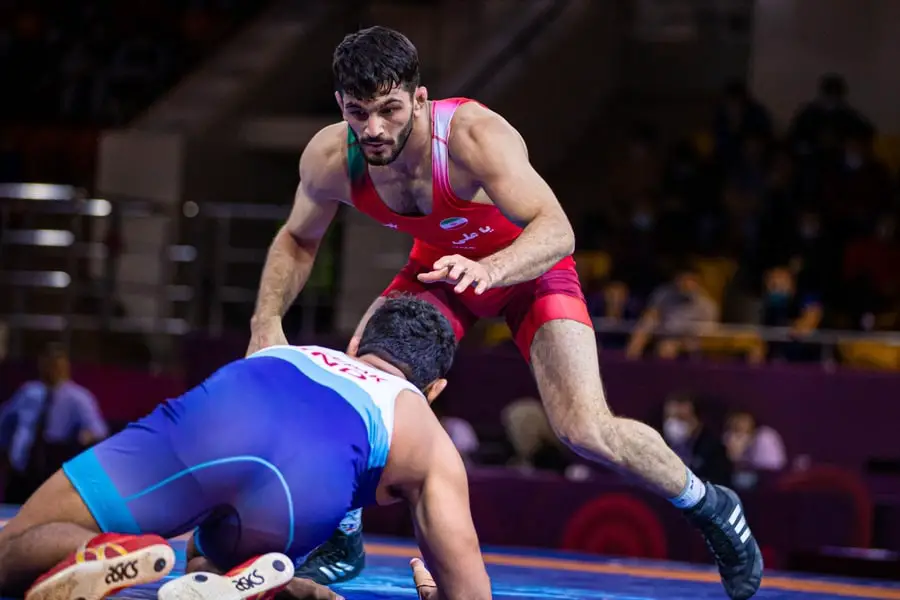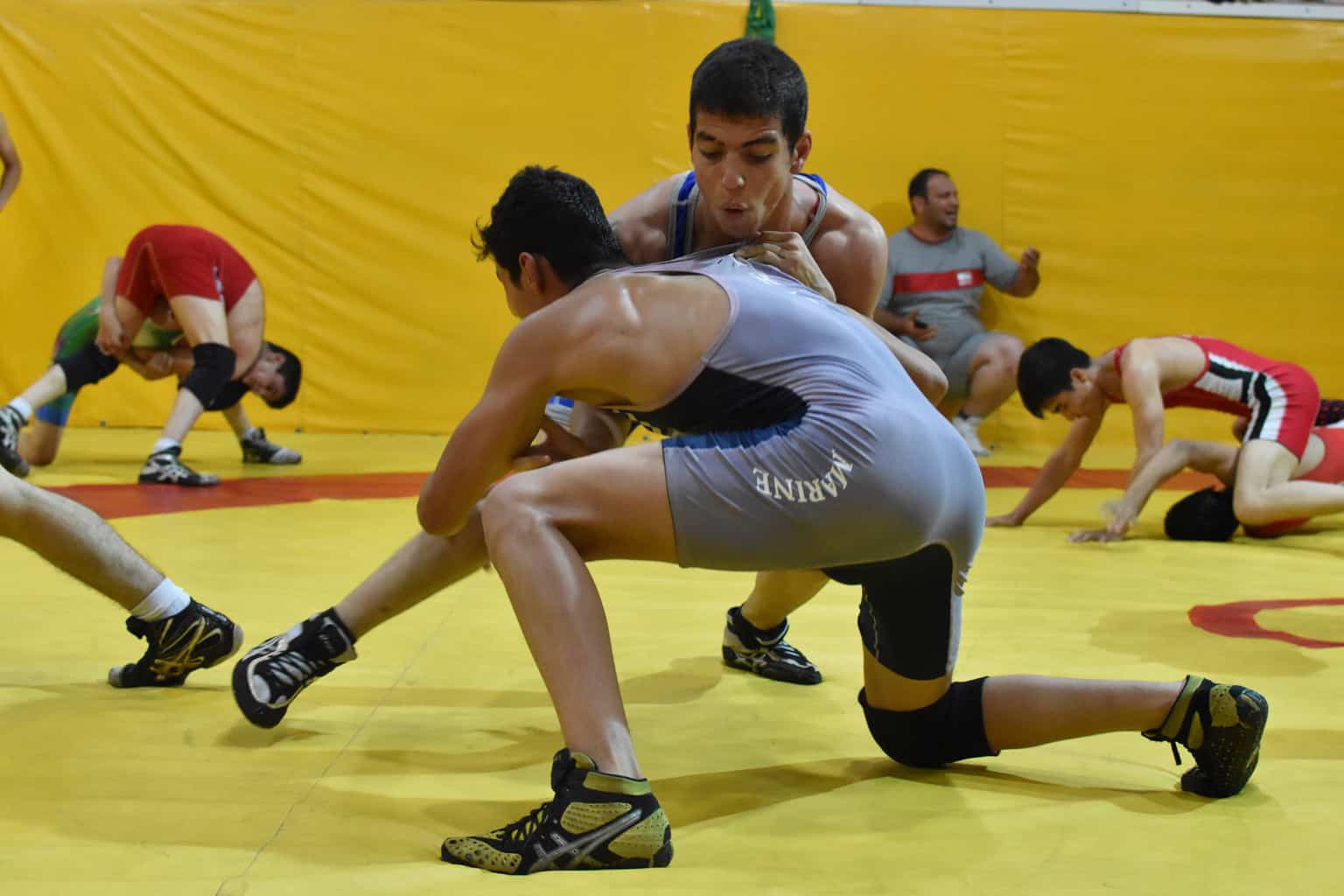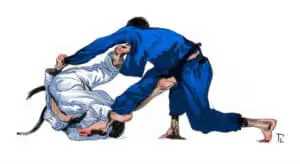The top 3 wrestling nations in the world are Russia, America and Iran. Rounding out the top 10 is Turkey, Georgia Azerbaijan, Cuba, Japan, India and Ukraine. In this article we are going to focus on the success of Iran and how they are able to produce world champions year after year in both Greco-Roman and freestyle wrestling.

Why Is Iran So Good At Wrestling?
Iran is so good at wrestling because the sport is highly popular with many children training from a young age. Iran has numerous wrestling clubs run by former world champions who know how to develop athletes. Also Iranian wrestlers have an effective style based on underhooks and forward pressure.
Wrestling Is Very Popular In Iran
The backbone of having success in a particular sport is participation. To explain this effect just think of two different countries Country A has 1 million wrestlers and Country B has only 1000, which country is more likely to produce Olympic and world champions? Obviously Country A even if they have terrible facilities, poor coaching and no support just based on those high numbers some wrestlers will succeed.
In Iran there are almost 500,000 wrestlers which is up there with the most in the world. Only Russia and the USA can boast to have more active wrestlers than Iran. Wrestling is considered Iran’s national sport and is the second most popular after soccer.
Due to the amount of wrestlers in Iran based on the law of large numbers they have a much higher chance of finding gifted athletes who also have the focus and love of the sport to become world class and win championship medals.

Why Is Wrestling So Popular In Iran?
Wrestling is so popular in Iran because it is deeply intertwined into the culture. In Ancient Persia warriors would wrestle as part of their training and the best wrestlers were highly respected. The Ancient Persian hero Rustam of Ferdowsi’s epic was also a wrestler.
Northern Iran (where most of Iran’s top wrestlers including Yazdani hail from) is located in the Caucasus mountains which is an absolute hotbed of wrestling and produces the vast majority of the wrestling talent in the world. The Caucasus mountains include nations such as Russia, Armenia, Azerbaijan, Turkey and Georgia. The people in these regions have been wrestling for thousands of years as forms of entertainment, methods of dealing with disputes and training for combat.
To highlight the importance of wrestling in Iranian and Persian culture you only have to look at Ferdowsi’s epic poem Shahnameh. This poem mixes mythology with the history of Iran and is considered the fundamental text of the nation. In this epic one of the main characters is a heroic warrior named Rustam who was not only one of the mightiest warriors in all of Persia but he was also a mighty wrestler.
Iranians love of wrestling has led them to flock to the modern sports of freestyle wrestling and Greco-Roman wrestling as this is a way to honor their culture while also bringing fame and glory to their themselves, their nation and family. Due to the history of wrestling in Iran, wrestler’s are highly respected members of society and excelling in the sport can help athletes attain positions of influence, start successful businesses, rise up the social ranks and earn lots of money. While Iranian wrestlers don’t receive much official support from the wrestling federation they can use their profile and social status to build wealth.
How Do Wrestlers Train In Iran?
In Iran local boys join wrestling clubs at 7 years old where they start learning under the nearly 2000 coaches spread throughout the country. Iranian wrestlers place large emphasis on technical proficiency but also physical strength as weightlifting is a major component of wrestling training in Iran.

Iran is similar to Russia in the way wrestling is structured. Boys do not wrestle as part of their school instead they wrestle for local clubs where they spend years under the watchful eyes of former champions who take them from young novice to seasoned champion. However, there are some key differences between how Iran and Russia develop athletes.
Iranian wrestlers tend to start a little younger than Russian wrestlers (7 vs 10) and in Iran young wrestlers are developed more quickly. Iranian boys will be taught complex throws and leg attacks from an early age which they are expected to master. While in Russia the development is slower with an increased focus on general training and specific wrestling skills are taught much slower.
In Iranian wrestling development general training and gymnastics are not as emphasized compared to the Russian school of training. Instead weightlifting plays an important role with many Iranian wrestlers squatting, dead lifting, bench pressing and performing Olympic weightlifting movements similar to how Americans develop their strength. This is in stark contrast to the Russian training methodology where heavy weightlifting is very rare with most wrestlers sticking to classic exercises such as rope climbs, pull ups, dips and bodyweight ab movements.
Another difference between the Russian and Iranian school of wrestling is the Iranian national team including age group teams will train together on a regular basis. While Russia does hold national training camps most wrestlers stay in their respective republics for the majority of the year and train with the regional team.
Just like nearly all Russian wrestlers come from the Caucasus region particularly Ossetia and Dagestan (the 2020 Tokyo Olympic Russian freestyle team had 6 members, 3 from Ossetia and 3 from Dagestan) the vast majority of Iranian wrestlers come from a region of Northern Iran known as Mazandaran.
What Is Iran’s Style Of Wrestling?
Iran has a unique style of wrestling that is characterized by a very high pace, deep underhooks and using superior leverage and head positioning to drive their opponent around the mat. Iranian wrestlers are known for using heavy collar ties and using snaps and underhooks to set up single legs.
Each region of the world has their own unique style of wrestling. Iran seems to be a blend of the American and Russian style of wrestling with some of their own flair. Iranian wrestlers are come forward pressure fighters who use heavy collar ties and snapdowns to wear out their opponents. They really wrestle at a high pace which many of their opponents can’t handle. This high pace combined with the clubbing collar ties and snaps is similar to how many Americans wrestle.
They combine their working the head tactic with a deep underhook and driving their head into the jaw of their opponent. This positioning allows them to force their opponent backwards presenting the opportunity to score step outs, force cautions (penalty points) and to take advantage of desperate opponents who try to push back and circle away. The mastery over the underhook position is a unique skill among Iranian wrestlers.
Iranian wrestlers aren’t just super strong bulls they also have some finesse. They will use their tie ups and underhooks to get to their opponent’s legs where they will then implement their pretty technique to finish and score points. Their high percentage finish rate when they snatch a leg is similar to Russian athletes.
If you want to watch one wrestler who embodies the Iranian style of wrestling you need to check out Yazdani. See his highlights below!
